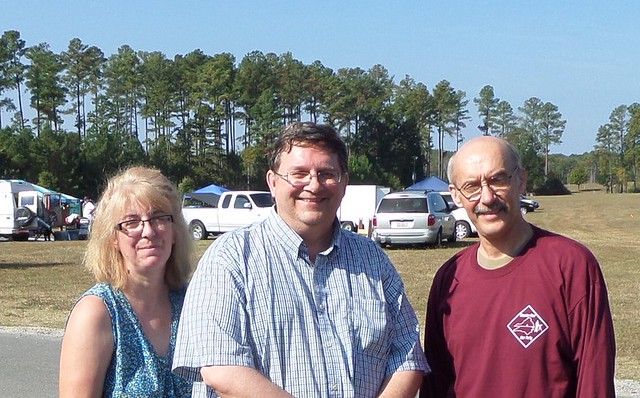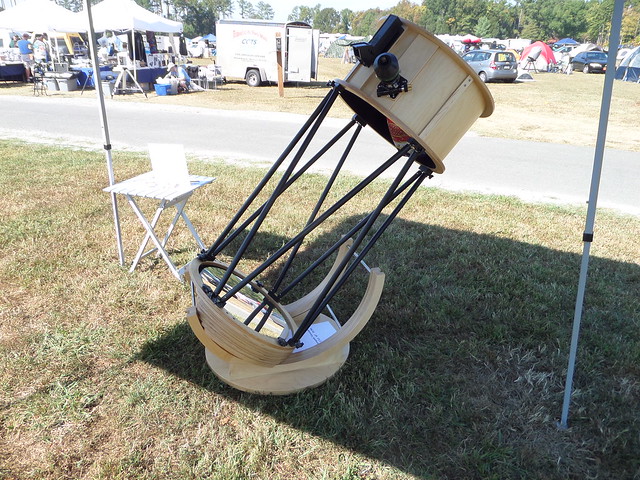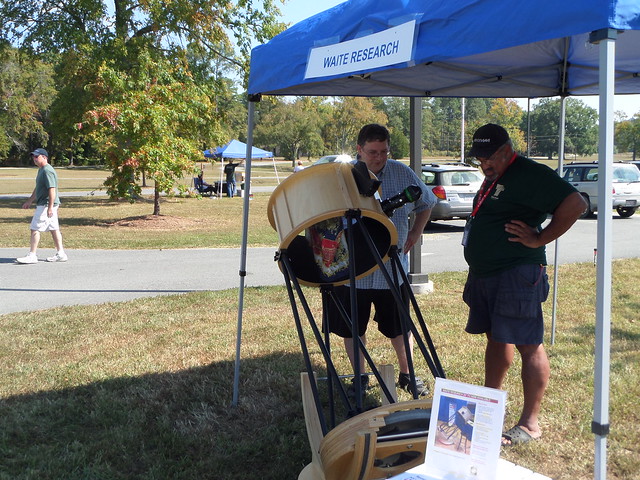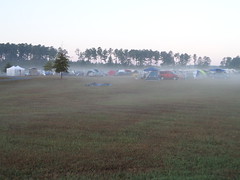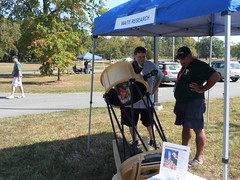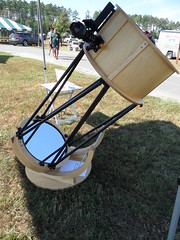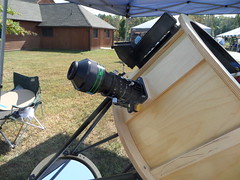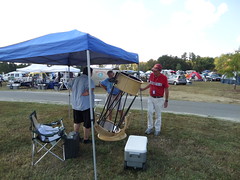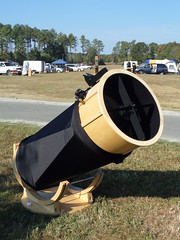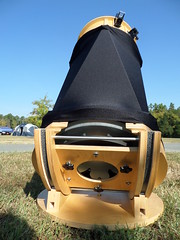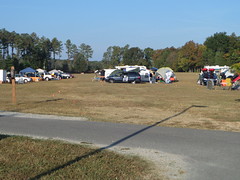The 2013 Staunton River Star Party Experience
Oct 08, 2013
[At the bottom of this Blog you will find all the images we took at the Staunton River Star Party. Click on that block to run the slideshow!]
With any Star Party, you are rolling the dice, hoping for clear skies and working telescope equipment. At this year's Staunton River Star Party, we hit the jackpot! This was the finest experience we've had, and I cannot recommend enough that you attend this event the next time around. I guarantee, this is the best-run, most well-thought-out event that you will see.
Much of the credit for the success of this Star Party goes to Jayme Hanzak, the president of the Chapel Hill Astronomical and Observational Society (CHAOS). Jayme met us soon after our arrival, and he was able to help us get set up in the Vendor area and ready for action. And later on Friday night, Jayme accepted my invitation to sit and chat in the dark. He told me the story of how the SRSP came into existence, and shared many of the reasons why it has prospered, even as a new event that has starting up over just the last three years. Any star party is a tremendous pile of details, and all the folks who worked so hard to make the event happen get a HUGE thumbs-up from us. We really appreciate all of the hard work that you all put in!
The list of "features" at the SRSP is long... Working Internet access, a great meeting room, a huge observing field, tremendous food serivice, cell phone access, electricity all over the observing field, red lights in the cafe and restrooms and along all the paved areas... the list just goes on and on.
I have to admit that our trip from New Jersey to the southern edge of Virginia was a bit brutal. The computer had told us to expect a seven-hour drive. But traffic and construction south of Washington D.C. added a full three hours to that number! We did have a chance to pass by the Washington Monument and the Capitol building and the Pentagon. Given the political events of these days, we weren't surprised to see road blocks in front of the NSA building and others, letting us know they were closed due to the government shutdown. Later, on the way home, we also were kept from seeing Appomattox Court House, where Lee surrendered to Grant to end the Civil War.
The SRSP is a long event, beginning on Tuesday and ending on Sunday. Jayme and the Star Party crew hit it big, getting five clear nights in a row! How they arranged for THAT we don't know, but there sure were a lot of happy astronomers on the field! The sky was just beautiful, with good horizons and wonderful views of the Milky Way. Given our home in New Jersey, it's always good to have a chance to see our own galaxy, up close and personal.
During the day we set up the 20" Renegade under a canopy to give us some shade from the hot sun. We were really thankful for the canopy! We were able to stay cool and host our visitors in relative comfort. Plus it kept the Renegade at a temperature that made it possible to observe after the sun went down. We used our IR thermometer to check a couple of telescopes out on the observing field. We found mirrors as hot as 145F, and one black car we checked was well over 160F!
When packing before leaving for the SRSP, I had to completely disassemble the Renegade to fit it in with all of our camping gear. I was also testing, for the first time, our new 18-point mirror cell. So I was thinking about collimation and whether it might take a little longer than usual to get the 'scope ready for guests later that night. When I was checking out items for sale at Camera Concepts and Telescope Solutions across from our tent, I saw they had an Astrosystems autocollimator for sale. I thought I would give it a try, so I bought it to help collimate the Renegade later toward evening. My worries about collimation turned out to be unfounded. People think that collimating such a fast telescope is difficult, but in reality it only takes a few minutes.
When I assembled the telescope and got the truss poles in place, I popped the regular collimator into the focuser. The laser's red dot was a couple of inches from the center marker on the mirror. A few turns of the collimation knobs on the secondary holder corrected that. Then with my son, Emerson, tweaking the knobs on the back of the Renegade, we got the laser beam centered back on the face of the collimator in the focuser. When I put the Astrosystems autocollimator in place of the laser, I looked and saw three images of the center marking circle. Literally, two or three tweaks of the secondary adjustment knobs got all the rings to overlap perfectly, and the Renegade was ready for action. Total time for collimation was probably five minutes, tops!
After sunset and past twilight, we were visited by a steady stream of folks stopping by to have a few looks through the Renegade. This was just so much fun. Early in the night we looked at some classic objects, such as M57 (the Ring Nebula), M13 (the Hercules globular cluster) and M27 (the Dumbbell Nebula.) Mostly we used the 22mm Nagler 4, which gave a magnification of 80x with the Type 2 Paracorr, with a field of view of 1.0 degree. As the night went on, the Double Cluster in Perseus (NGC 869 and NGC 884) rose above the tree line. We switched to the 31mm Nagler 5 (57x, 1.4 degree FOV) and enjoyed seeing both clusters in one look through that giant eyepiece! Even with the "oversized" exit pupil, this eyepiece gives fantastic performance with the Renegade.
The best view of the evening may have been "the M31 experience" with the Renegade and the 31mm Nagler 5. At first, we would get the Andromeda Galaxy centered up in the eyepiece, and enjoy seeing the galaxy going pretty much all the way across the field of view. Then we would move a little left and see M32, a companion galaxy. Switching to the right, we found M110. After doing this dance quite a few times, I suddenly realized that I could actually see ALL THREE GALAXIES simultaneously in the wide, 1.4-degree field of view! Of course, that is one of the big benefits of the 20" F3 Renegade. The field of view with the 31mm is 1.41 degrees versus .82 degrees for a 20" F5! The images are brighter, and it is far easier to find objects and keep them in the field of view.
The bright views through the Renegade made it quite easy to observe more difficult objects like M33, the Pinwheel Galaxy in Triangulum. While this is a relatively large object, it has a very low surface brightness. That makes it hard to find in many telescopes. But the Renegade really made this an easy object, with a bright image of this beautiful galaxy, centered in a wide field of view.
We observed with the Renegade into the wee hours of the morning, and then things quieted down on the observing field, and traffic fell off. Emerson and I spent a couple of hours under the sky. We alternated between sitting in the comfy chairs, looking at the stars, and walking around the Park, guided by all the little red lights next to the paved roads. As we watched Orion rise, with Jupiter and the Pleiades in tow, we saw a bunch of meteors, including a couple that left persistent glowing trails. In total we probably saw twelve or fifteen, which was a nice cap on all of our observing.
After a few hours of sleep, the sun got high enough to wake us up, so we headed down to the cafe. There we found Jayme enjoying breakfast. We joined in, ordering biscuits, eggs, bacon and sausage. Both Renee and I had completely forgotten what a REAL biscuit tastes like, and being re-introduced was a real treat! Renee got one more refill of that bottomless coffee cup, and we both enjoyed the meal. Now fully fueled, we gave our thanks and said our goodbye's to Jayme, finished packing and hit the road north.
New friends at the Star Party recommended that we return on 81, enjoying the views of the western Virginia mountains, all the interesting stuff along the road, and the autumn trees just starting to turn colors. I can't thank enough those who recommended the western route back. It was a beautiful drive! We ended up making a big loop. We were a little surprised when we realized our trip started in New Jersey, then hit Delaware, Maryland, Virginia, West Virginia and Pennsylvania before getting us back to NJ. We made a brief stop in West Virginia to visit a Ryan's Buffet, then made our way into Pennsylvania to navigate their 8,000-mile-long construction zone in the dark. Somehow we made it, breaking through into New Jersey around 10pm. A bit over an hour later we came home to roost in Tinton Falls, tired from the 11-hour trip, but happy with all we had experienced at the Staunton River Star Party, and especially happy to have made so many new friends there.
Add Pingback


